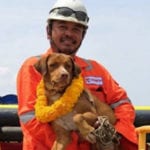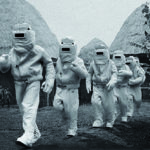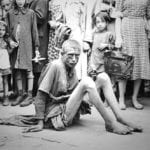 Our World
Our World  Our World
Our World  Pop Culture
Pop Culture 10 Incredible Female Comic Book Artists
 Crime
Crime 10 Terrifying Serial Killers from Centuries Ago
 Technology
Technology 10 Hilariously Over-Engineered Solutions to Simple Problems
 Miscellaneous
Miscellaneous 10 Ironic News Stories Straight out of an Alanis Morissette Song
 Politics
Politics 10 Lesser-Known Far-Right Groups of the 21st Century
 History
History Ten Revealing Facts about Daily Domestic Life in the Old West
 Weird Stuff
Weird Stuff 10 Everyday Products Surprisingly Made by Inmates
 Movies and TV
Movies and TV 10 Actors Dragged out of Retirement for One Key Role
 Creepy
Creepy 10 Lesser-Known Shapeshifter Legends from Around the World
 Our World
Our World 10 Science Facts That Will Change How You Look at the World
 Pop Culture
Pop Culture 10 Incredible Female Comic Book Artists
 Crime
Crime 10 Terrifying Serial Killers from Centuries Ago
Who's Behind Listverse?

Jamie Frater
Head Editor
Jamie founded Listverse due to an insatiable desire to share fascinating, obscure, and bizarre facts. He has been a guest speaker on numerous national radio and television stations and is a five time published author.
More About Us Technology
Technology 10 Hilariously Over-Engineered Solutions to Simple Problems
 Miscellaneous
Miscellaneous 10 Ironic News Stories Straight out of an Alanis Morissette Song
 Politics
Politics 10 Lesser-Known Far-Right Groups of the 21st Century
 History
History Ten Revealing Facts about Daily Domestic Life in the Old West
 Weird Stuff
Weird Stuff 10 Everyday Products Surprisingly Made by Inmates
 Movies and TV
Movies and TV 10 Actors Dragged out of Retirement for One Key Role
 Creepy
Creepy 10 Lesser-Known Shapeshifter Legends from Around the World
10 Amazing (and Heartbreaking) Stories of the Soviet Space Dogs
Before the 1969 Apollo 11 mission put U.S. astronauts on the moon, hundreds of missions preceded it. The whole reason for the space race was for both sides, with tensions high due to the Cold War, eager to test missile capability and distance via space exploration. While the U.S. was the first to land a man on the moon, the Soviets were the first to put a living creature into orbit and the first to put a human into space, which they did in 1961.
But before man was sitting in a rocket, all manner of other living creatures were forced to take the lead. The U.S. favored chimpanzees for their close genetic structure to humans, but the Soviets preferred dogs. Some 36 different dogs were used over a 15-year period, and many of them died or have been forgotten by history: these are 10 of their stories.
Related: 10 Historical First Images Captured Of Space
10 Dezik, Tsygan, and Lisa
It’s important to remember that in the 1950s, neither the Soviets nor the U.S. spaceflight teams knew if life even could survive in space, nor did they know for sure that firing something into orbit, let alone it coming back safely, was possible.
By the dawn of the ’50s, the Soviets were already playing catch up. In 1948, three years before Russian testing on live animals began, their American rivals successfully launched a rhesus monkey named Albert into sub-orbital space, followed by three others and a mouse, all of which died.
Dezik and Tsygan were selected as the first Soviet space dogs, and they traveled 68 miles high on August 15, 1951 (beating the American monkey Yorick by a month), returning unharmed. Continuing from this success, the Soviets sent Dezik up for a second flight, this time pairing her with a dog named Lisa. This one, however, ended in disaster as both dogs died when the module crashed. Not wanting to lose both of the first dogs in space, Tsygan was swiftly retired and adopted by a Soviet physicist.[1]
9 Bolik and ZIB
All the dogs used by the Soviets were strays, usually picked off the streets of Moscow and kept in a compound, where they were trained and prepared. For every dog that took part in a mission, there were countless others that either died during training, escaped, were used as backups for Earth-based control groups during missions, or simply weren’t up to scratch.
Although the training and preparation varied depending on the mission, the dogs were generally placed on centrifuges to prepare them for the high speeds. They were also put in cages getting progressively smaller and smaller to prepare them for the cramped, motionless conditions of space flight.
All of this was too much for Bolik, who, just a month after the failure of the Dezik and Lisa mission, ran away a few days before his scheduled flight. The craft and equipment had been designed around Bolik’s size and weight, and no other dog on site would suffice. Luckily for the Soviets, they found a stray running around outside their compound. Untrained but the perfect dimensions, she was dubbed ZIB: an acronym for the Russian translation of “replacement for missing Bolik.” Thankfully, this mission was successful, and the untrained, unsuspecting ZIB returned safely.[2]
8 Laika
On November 3, 1957, the first celebrated achievement on either side occurred when the Sputnik 2 Soviet spacecraft was fired into space. It was planned to coincide with the 40th anniversary of the Russian Revolution, so pressure was high, and deadlines were short…and on board the craft was poor little Laika.
The tight deadline imposed by the Soviet Premier meant that the flight couldn’t account for a return, so everyone knew going in that Laika (translated as “Barker”) would not be coming back. The plan was to complete multiple orbits of the planet and then crash back to Earth, with Laika expected to run out of oxygen after seven days and die painlessly.
For PR reasons, this was how her fate was recorded for some time, but now we know that she actually died just hours into the mission after temperatures rose to unexpected levels inside the craft during launch. A cruel and tragic way to go, but she became a hero in her time as the first living creature to fly into orbit. Her legacy lives on today, and she is honored in various monuments, in the Cosmonaut Space Museum in Moscow, and in popular culture all over the world.[3]
7 Bars and Lisichka

Riding high on the success of the Laika mission (from a technical perspective), the Soviet spaceflight team was still remorseful over the dog’s fate. No other mission before it was a suicide mission like Laika’s. They made improvements to the capsule, making it capable of returning from orbit, thus ensuring the same thing never happened again.
Bars and Lisichka were selected for this test mission, which launched in the summer of 1960. The latter of the two, Lisichka, was a favorite of Sergei Korolev—the lead rocket engineer and spacecraft designer for the Soviets (LINK 11). However, the preparation, training, and design of the craft would all be for nothing, in the swiftest failure of the spaceflight missions. Just 28 seconds into launch, the capsule exploded, killing both dogs. Much more work was apparently needed.[4]
6 Belka and Strelka
Three years later, the Soviet spaceflight team was scurrying around the streets of Moscow once again, looking for new candidates for its next mission. This time the hope was to send living organisms into orbit and have them come back alive.
The dogs chosen were Belka and Strelka (“Whitey” and “Little Arrow”), who were accompanied on Sputnik 5 by 40 mice, 2 rats, a rabbit, and some fruit flies and plants. On August 19, 1960, the launch occurred and went off without a hitch. After 17 orbits, they returned to Earth as intended, completely unharmed, becoming the first living creatures to reach orbit and return safely. Their success was reported worldwide, and both dogs retired and never flew again. A gigantic propaganda success, Soviet Premier Krushchev gifted a puppy of Strelka to the American First Lady Jackie Kennedy during the height of the Cold War, who grew up to have puppies with an American dog: a true Cold War romance.[5]
5 Pchelka and Mushka
During the space race, advancements, targets, and technology were kept secret from the public on both sides to keep their enemies from gaining the upper hand or profiting from their hard work. This was evidenced in the Pchelka (“Little Bee”) and Mushka (“Little Fly”) mission, which launched in December 1960. It was the first mission for Pchelka, but Mushka had played an important role in Laika’s flight three years earlier, acting as her control group on Earth.
After a successful launch and a day in orbit, an error occurred during reentry when rockets failed to switch off as planned and the capsule veered off target. Rather than allow it to land in foreign hands, the spaceflight team made the decision to self-destruct the capsule, killing both dogs. While happy to go worldwide with their successes, the Soviets still valued their secrecy first and foremost.[6]
4 Shutka and Kometka
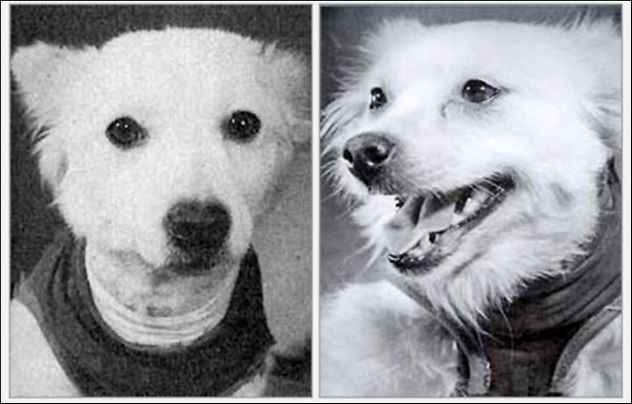
The very next flight was another failure. Launched on December 22, 1960, the dogs Shutka and Kometka (“Joke” and “Little Comet”), accompanied by mice, were scheduled to complete an orbital flight but only got as high as 133 miles before the upper stage rocket failed. Two ejection seats were fitted in the event of a disaster, but they were unable to deploy them, trapping the two dogs inside. The crew attempted to self-destruct the capsule, but this also failed to work, so they rushed to the craft.
It crashed 2,175 miles away, still within Soviet borders, sitting in a snowdrift in -42-degree-Celcius (-45-degree-Fahrenheit) temperatures. Unable to disarm the backup self-destruct mechanism (which had a 60-hour timer) due to the freezing temperatures and fading light, they were forced to wait until morning. The glass on the capsule was frosted over, and no signs of life were detected inside. However, as the sun rose the next day, the scientists heard dogs barking and disarmed the mechanism, pulling the dogs out of the module. Miraculously, they were unharmed, albeit in shock.
Both dogs fully recovered, but with the Soviets banning Korolev from telling the story of their survival publicly, they were forgotten. Thankfully, they were both retired, and Kometka was even adopted as a pet by Oleg Gazenko—a leading scientist who selected the dogs for many of the missions— and living a long and deservedly more relaxed life.[7]
3 Chernushka
To double up on research, the trend had been for the Soviets to use two dogs in missions, but with technology and understanding improving, they switched just one dog: a subtle hint that their intentions and future plans were changing. Behind the scenes, officials began setting their eyes on the first human spaceflight, but further tests were required.
Having tested their equipment and technology, as well as the effects of space, on small living creatures in tiny capsules, now the question was whether a craft large enough to fit a human could produce the same results. Test dummies were sent to find out, but the need for a living creature to test for livability meant the dogs’ missions weren’t over yet. Chernushka (“Blackie”) completed one orbit in March 1961 and returned safely. It was the first flight of its kind, and the success of which ramped up the plans for the first human flight the following month.[8]
2 Zvezdochka
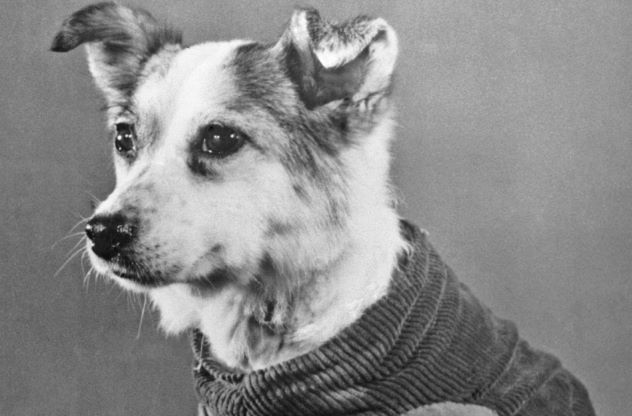
The final test flight before Yuri Gagarin’s planned mission was one of the most important tests the Soviet team had yet undertaken. A failure here would result in a launch delay or disaster for Gagarin. After the Chernushka mission, one final success was required for the spaceflight team to be satisfied everything was safe enough for Gagarin.
The dog selected went through the usual training; however, there was one issue: its name. The dog was called Udacha, which means “luck,” which Gagarin insisted on changing. Gagarin was extremely superstitious, and many of his rituals on his launch are still carried out today by Russian cosmonauts. The team was happy to go along with this and allowed Gagarin to rename the dog Zvezdochka (“Starlet” or “Little Star”). Whether this superstition had anything to do with it or not, the mission was another success, returning the dog unharmed back to Earth.[9]
1 Veterok and Ugolyok
For many, Gagarin’s flight marked the end of the space race. The Soviets had roundly beaten the Americans at every major hurdle along the way. But over in the USA, JFK swiftly changed the goalposts, publicly setting his country’s sights on the moon. Not to be outdone in this propaganda war, the new race began, but this one would require more time in space than any of the Soviet’s previous tests.
At this point, the record for continuous time spent in space (without death) was just five days, but it would certainly take longer than that to get to the moon and back. So in 1966, Veterok and Ugolyok were selected in what was to be the final dog-space mission. They were launched aboard a new craft and flown in orbit for a whopping 21 days before returning to Earth and landing safely. The dogs were paraded on television for a while and went on to live long ordinary lives. Ugolyok produced a litter of six puppies, and Veterok befriended a scientist working on the spaceflight team and lived to old age.[10]
